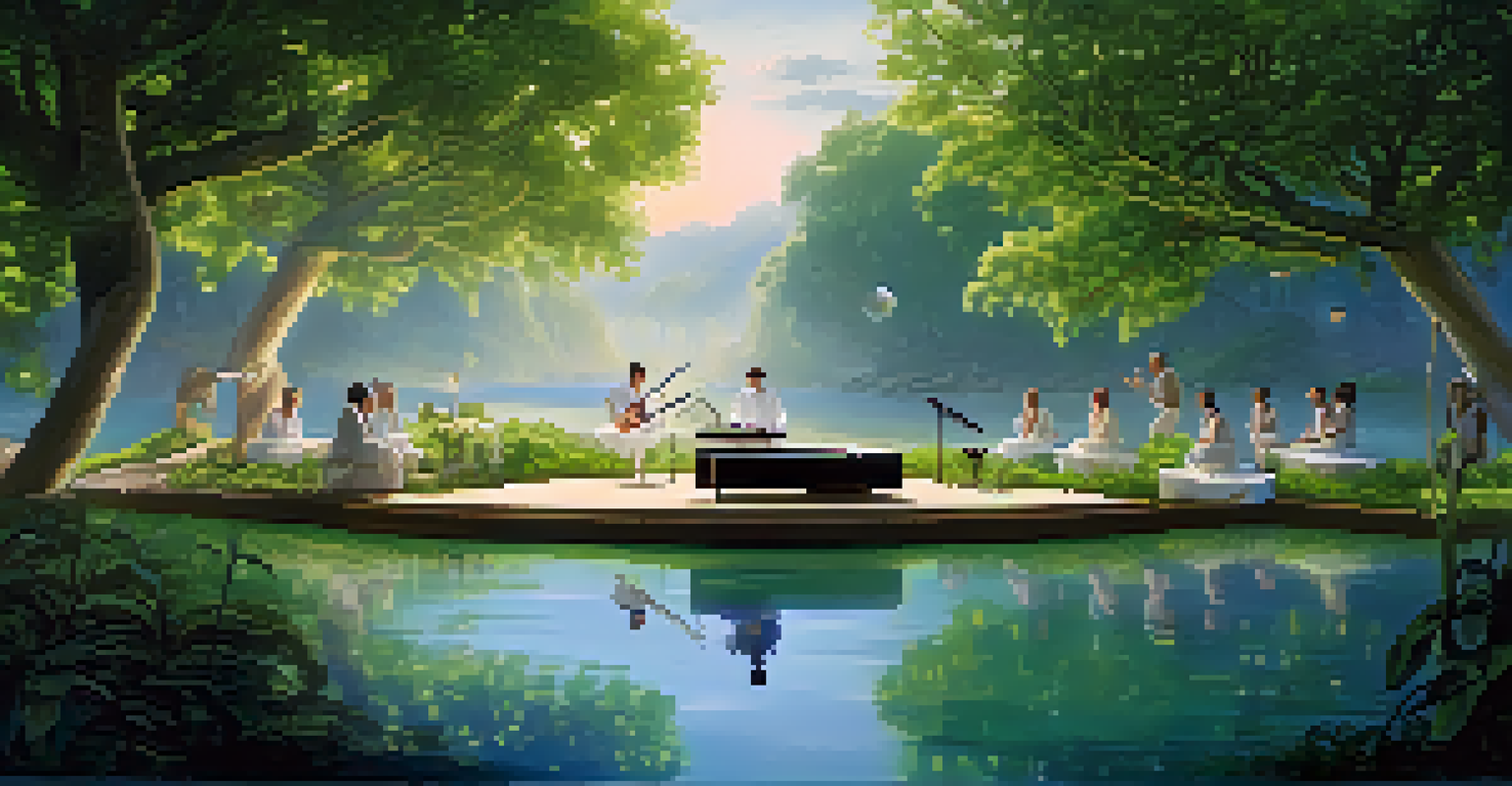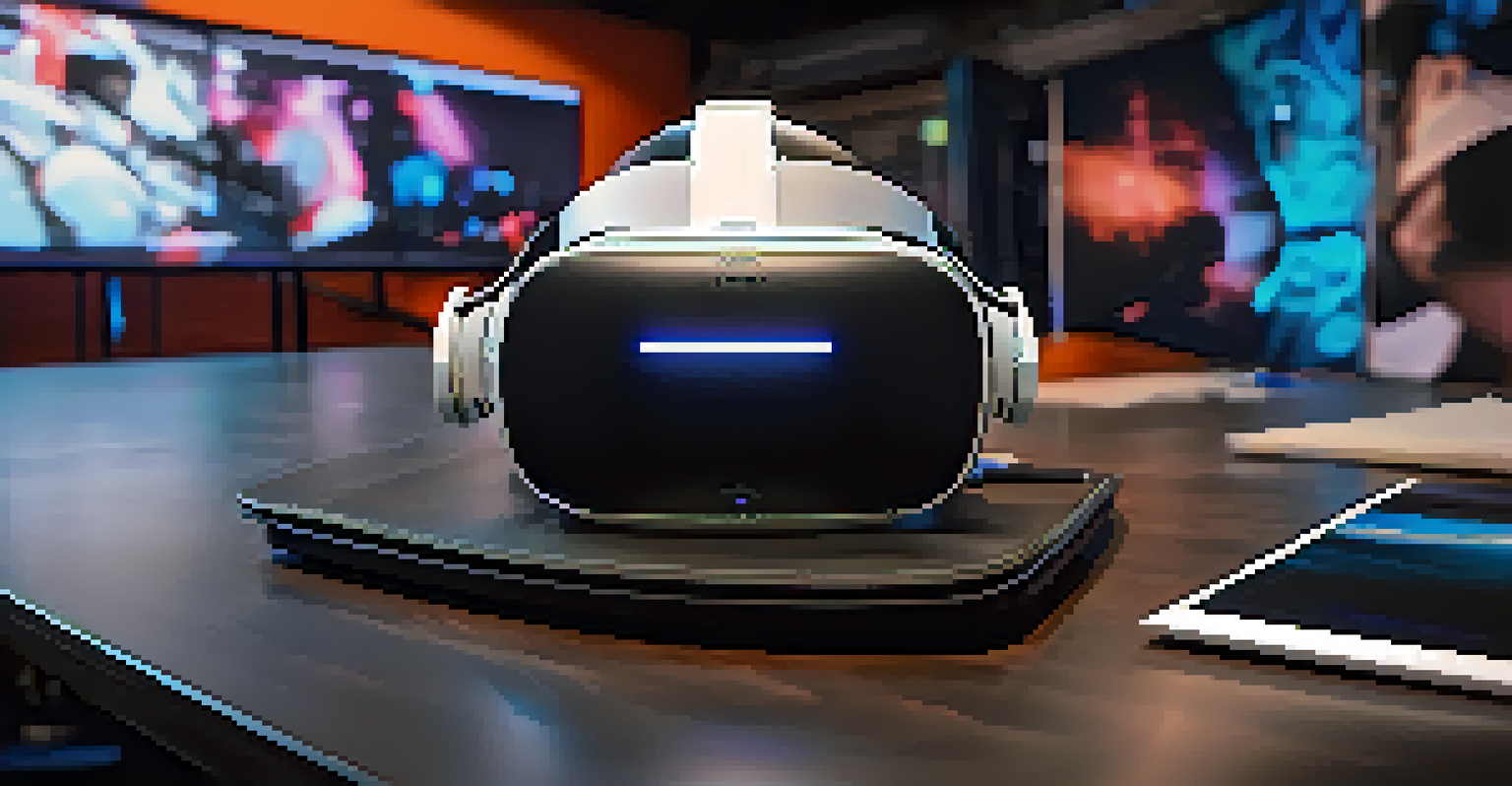Creating a Virtual Reality Concert Experience: Best Practices

Understanding the Virtual Reality Concert Landscape
Virtual reality concerts have transformed live performances, offering fans unprecedented immersion. Unlike traditional concerts, VR allows attendees to experience events from unique perspectives, whether they're front row or backstage. This shift not only enhances engagement but also opens doors for artists to reach global audiences without geographical barriers.
Music brings people together, and technology can amplify that connection in ways we’ve never imagined.
As technology advances, the demand for virtual experiences grows, making it essential for creators to understand the landscape. A well-executed VR concert can create a sense of community, as fans can interact with each other and the performers in real-time. This social aspect can be a game-changer in building a loyal fanbase.
Moreover, understanding the technical requirements and the audience's expectations is crucial for success. Creators must consider factors like platform compatibility, graphics quality, and user accessibility to ensure a seamless experience. In this exciting space, the possibilities are endless, but a solid foundation is key.
Choosing the Right Technology and Equipment
Selecting the appropriate technology and equipment is vital for a successful VR concert. High-quality cameras, microphones, and VR headsets should be prioritized to deliver an immersive experience. For instance, 360-degree cameras can capture the full scope of the performance, providing viewers with a lifelike sensation of being there.

Additionally, the choice of software for streaming and interaction can make or break the experience. Platforms like Oculus Venues and VRChat offer unique tools that allow for artist-audience interaction, enhancing the concert atmosphere. It’s crucial to explore and test various options to find what best suits the event's vision.
Immersive VR Concert Experiences
Virtual reality concerts offer fans unique perspectives and enhance engagement through real-time interactions.
Investing in the right technology not only enhances visual and auditory quality but also ensures a smooth, glitch-free experience for users. By blending cutting-edge tools with creative vision, creators can elevate their VR concerts to new heights.
Creating Engaging Content for Virtual Performances
Content creation is at the heart of any memorable VR concert. Artists should focus on delivering unique and engaging performances that resonate with their audience. This might include exclusive behind-the-scenes footage, interactive Q&A sessions, or even virtual meet-and-greets, making fans feel valued.
The future of live music is not just about the sound, but about the shared experience of the audience.
Incorporating elements like storytelling can further enhance the experience. For example, an artist might weave personal anecdotes or insights into their songs, creating a deeper connection with their audience. This narrative approach can transform a concert into a shared journey, inviting fans to be part of something special.
Moreover, visual effects and animations can amplify the concert experience. Creative lighting and stage design can be replicated in the virtual world, helping to transport viewers into a different realm. By marrying compelling content with captivating visuals, creators can ensure their VR concert captivates and entertains.
Designing an Immersive Virtual Environment
The virtual environment sets the stage for an unforgettable concert experience. Thoughtful design can transport attendees to vibrant, imaginative worlds that enhance the performance. Whether it’s a futuristic cityscape or a serene natural setting, the chosen environment should complement the artist's style and music.
User experience is crucial in this digital realm. Attendees should be able to navigate easily, whether they want to explore the virtual space or focus on the performance. Intuitive controls and clear guidance can help prevent frustration, allowing fans to fully immerse themselves in the experience.
Choosing the Right Tech Matters
Selecting high-quality technology and platforms is crucial for delivering a seamless and immersive virtual concert experience.
Additionally, incorporating interactive elements, like clickable objects or areas to explore, can make the concert feel more dynamic. These features encourage audience participation, fostering a sense of agency within the virtual space. Ultimately, a well-crafted environment can elevate the concert from a mere performance to an unforgettable adventure.
Promoting Your Virtual Reality Concert Effectively
Promotion is key to attracting an audience to a virtual reality concert. Utilizing social media platforms can create buzz and excitement around the event. Engaging teaser videos, behind-the-scenes clips, and countdowns can pique interest and encourage fans to share the experience with others.
Collaborating with influencers or artists in the same genre can also expand reach. When fans see familiar faces endorsing the event, they’re more likely to join in. This type of partnership can help create a community feel, drawing in attendees who might not have otherwise participated.
Moreover, leveraging email marketing can keep your audience informed and engaged. Regular updates about the concert, exclusive offers, or sneak peeks can keep the momentum alive. A well-structured promotional strategy can significantly boost attendance and overall engagement.
Testing and Optimizing the Virtual Concert Experience
Before the big day, testing is essential to ensure everything runs smoothly. Conducting dry runs with a small audience can help identify technical glitches or areas for improvement. This proactive approach allows creators to refine the experience and address potential issues before they impact viewers.
Gathering feedback during these test runs can also provide valuable insights. Audience reactions can help gauge what works and what doesn’t, guiding adjustments in real-time. This iterative process can significantly enhance the final product, ensuring it meets expectations.
Engaging Audiences is Key
Real-time audience engagement, such as live chats and interactive features, fosters a sense of community and enhances the concert experience.
Finally, optimizing the concert experience based on analytics post-event is equally important. Analyzing viewer engagement, drop-off points, and overall satisfaction can inform future concerts. This continuous improvement cycle ensures that each virtual concert becomes better than the last.
Engaging with the Audience During the Concert
Audience engagement during the concert is crucial for creating a memorable experience. Real-time interactions, such as live chats or polls, can make viewers feel like they are part of the show. Encouraging fans to share their thoughts or reactions can foster a lively atmosphere, even in a virtual setting.
Additionally, utilizing avatars or virtual personas can enhance the social experience. Allowing attendees to create their own virtual identities can lead to more personal interactions. This customization helps break down barriers, making fans feel more connected to each other and the performance.

Incorporating live reactions or shout-outs from the artist can further boost engagement. When performers acknowledge their fans in real-time, it creates a sense of community that resonates long after the concert ends. By prioritizing audience interaction, creators can turn a one-time event into an ongoing relationship with fans.
Evaluating the Success of Your Virtual Concert
After the concert, evaluating its success is vital for future improvements. Metrics such as attendance numbers, engagement levels, and viewer feedback provide insights into what resonated with the audience. This data-driven approach can help creators understand their strengths and areas for growth.
Surveys or feedback forms can be effective tools for gathering audience opinions. Asking attendees what they loved and what could be improved can yield valuable information. This feedback loop not only shows fans that their opinions matter but also helps shape future events.
Lastly, celebrating successes and sharing highlights can keep the momentum alive. Posting memorable clips or testimonials can reinforce the community feel and encourage fans to look forward to future concerts. By evaluating success thoughtfully, creators can continue to evolve and enhance their virtual concert offerings.